branding - lecture
1/115
There's no tags or description
Looks like no tags are added yet.
Name | Mastery | Learn | Test | Matching | Spaced |
|---|
No study sessions yet.
116 Terms
Brand
A name, term, sign, symbol, or design, or combination of them, which is intended to identify the goods and services of one seller or group of sellers and to differentiate them from competitors - Kotler, 1991, p. 442
Hyperconnectivity
Blurring of brand boundaries → shared ownership, co-creation, control, etc.
Broadening of brand boundaries → when does something become a brand?
When it starts being managed → position in a certain way, push to a certain audience, decrease negative associations
Why? → for the exchange of goods, services, and values
Brand Value Chain
The multipliers/filters are moderators between the value stages (affect the strength of the relationship)
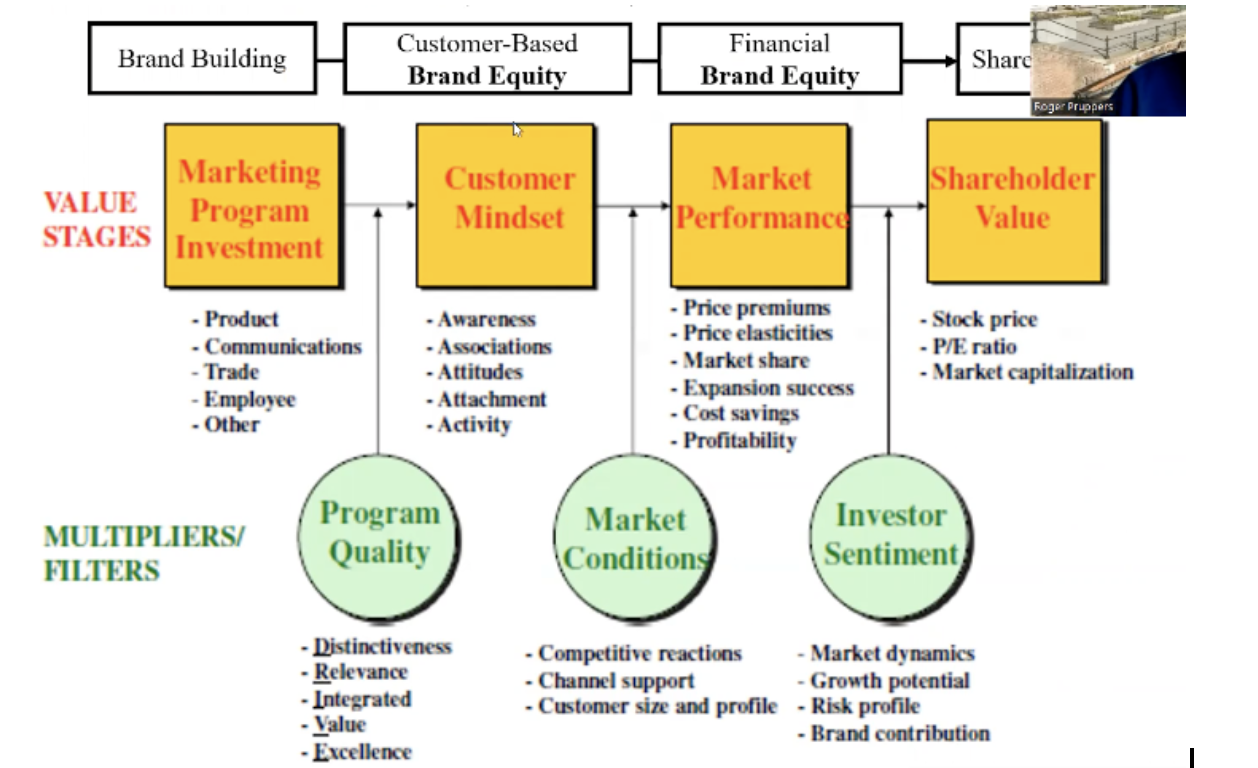
Brand Associative Network
Start to see patterns btw what multiple ppl think of when they bring a brand to mind
Types of associations (Keller 1993)
Functional vs symbolic
Attributes vs. benefits
Brand image
aggregation of all the ind. associative networks
Keller’s CBBE pyramid
Salience
Performance / Imagery
Judgements / Feelings
Resonance
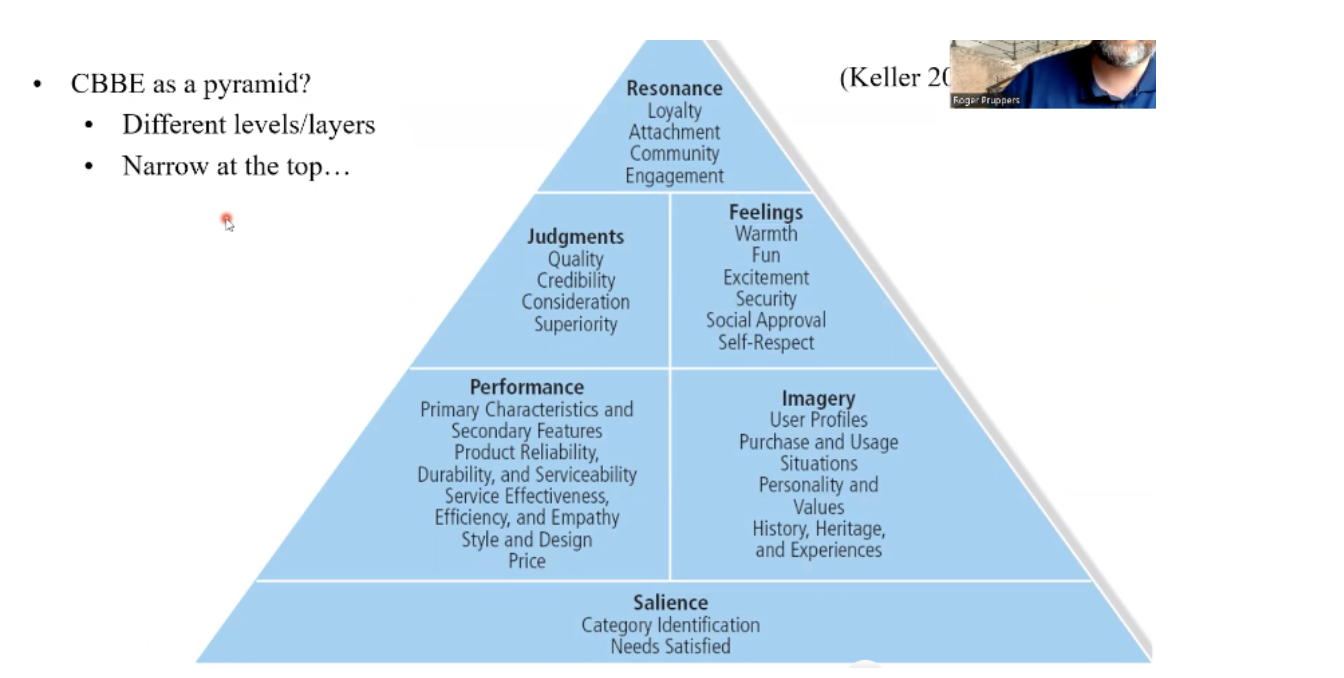
Brand Awareness - Recall vs. Recognition (Keller 1993)
Recall → given category, then ask question (can they think of it)
Recognition → show icon, logo, jingle, packaging (can they recognize it)
RECOGNITION TENDS TO BE HIGHER
Depth vs. Breadth (Keller 2016) (in terms of associative network)
Depth: how much info about a brand comes to mind
Breadth: broaden the range in which brand comes to mind
what are consumer insights?
A fresh and non-obvious/not-yet obvious way of understanding customer needs & behaviors (but has to be obvious enough so that it makes sense)
Or more importantly: customer frustrations
= can become the basis for a business opportunity
4 Ws: Sawhney paraphrased (video)
What do they (not) do/want?
Understand non-customers of brand/category → Explore barriers to consumption!
Why do they (not) do/want it?
Explore underlying motivations
“WOW, I did not know/realize that!”
The “not yet obvious” part, e.g. learn from different contexts
Where is the commercial potential?
How can we make strategic use of this?
Schultz - rethinking brand development in an interactive marketplace (6 new areas of brand research)
Shift to behavioral data
Longitudinal analysis
Networked systems = shift away from individualistic
Multidimensional models
Financial focus
Connections to/inclusion of other orgs/technologies in brand development = build brands w/o HUGE budgets
Brand positioning
The act of designing the company’s offer and image so that it occupies a distinctive place in the minds of the target market.
Brand image (engine) vs. brand positioning (mechanics)
Image: Aggregated/overlapping associative network(s) → Measured (consumer behavior)
Positioning: Desired brand image → Created (marketing strategy)
The fine-tuning; analyzing the associations
what does association SFU stand for?
strong, favorable, unique/differentiating
What’s the WORST combination of SFU?
strong & favorable but not unique
what are PoD’s?
POINTS OF DIFFERENCES
= Strong, favorable, AND unique associations
Provides the “Reason to buy”
USP (Unique Selling Point)
For product & service brands!
Left & right in pyramid!
3 q’s you need to ask about your brand?
Have we established a frame?
Are the PoD’s compelling?
Are we leveraging PoP’s?
diff parts of PoD’s?
deliverability
feasibility
profitability
sustainability
communicability
desirability
(perceived) relevance
believability (reasons to believe = RtB’s)
what are PoP’s?
= Strong, favorable, and NOT unique associations
allow product to be considered as an option
3 types
what are the 3 types of PoP’s?
Category = establish category membership
Competitive = negate competitor’s PoD’s
Correlational = negatively correlated attributes —> reach “par” level w/ one PoP to make a PoD believable/desirable
when are PoPs communicated explicitly?
when they’re not a category standard (competitive pop)
when the association is “suspicious” (potential conflict with PoD —> correlational)
PoD vs. PoP - which is more important?
PoP gets you in the door, gets you considered
PoD makes you stand out
= you need BOTH → first PoP, then PoD
RtB = reason to believe → supplemental to support your PoD (vitamin E in the dishwashing soap)
what is a positioning statement?
NOT slogan
NOT a major report
NOT value proposition
IS an internal tool that guides brand positioning
Short, to the point, complete
Strategic guidance → Relevance, urgency, differentiation
What, why, when, how, for whom?
Brands with functional brand concept…
Satisfy practical needs
E.g. problem prevention/solution
Brands with symbolic brand concept…
Satisfy symbolic needs
E.g. prestige, status, self-expression
Brand concept
The abstract meaning and essence that defines how consumers understand and relate to a brand. It helps form the basis for how the brand is marketed, perceived, and experienced by its audience.
They exist in the mind of the consumer
brand knowledge tree
brand personality as part of brand image
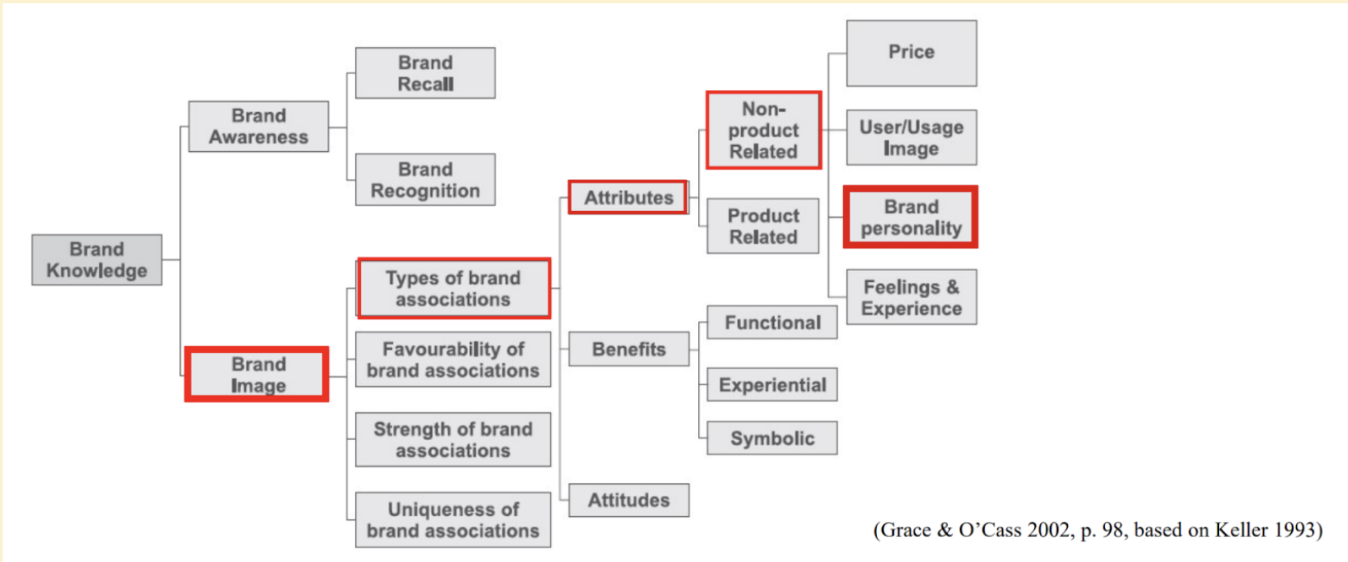
Maehle - 5 personality dimensions
sincerity = family values, high morals, positive service experiences, and reliability
excitement = aesthetic appeal, youth culture, special occasions, and social experiences
competence = judged based on their product quality, long-standing reputation, and market leadership
sophistication = high-class, exclusive, often linked to femininity and beauty
ruggedness = masculinity, toughness, and outdoor adventure
direct & indirect antecedents of brand personality
Direct:
user imagery (who uses the product)
endorsers
shareholders/CEO/employees
Indirect:
price
logo
product category
why is brand personality important?
Brands as instruments of self-identification → who are you/who do you want to be?
Strike a neve with consumers
Harder for other brands to copy
Less vulnerable to competitive positioning
how is brand activism diff from CSR?
More about values/beliefs, less about actions/results
More about controversial, contested, polarizing sociopolitical issue(s) = more risky
Brand activism typology (4 types)
Absence of brand activism: low marketing messaging & low prosocial corporate practice
Silent brand activism: low marketing messaging & high prosocial corporate practice
Authentic brand activism: high marketing messaging & high prosocial corporate practice
Inauthentic brand activism: high marketing messaging & low prosocial corporate practice
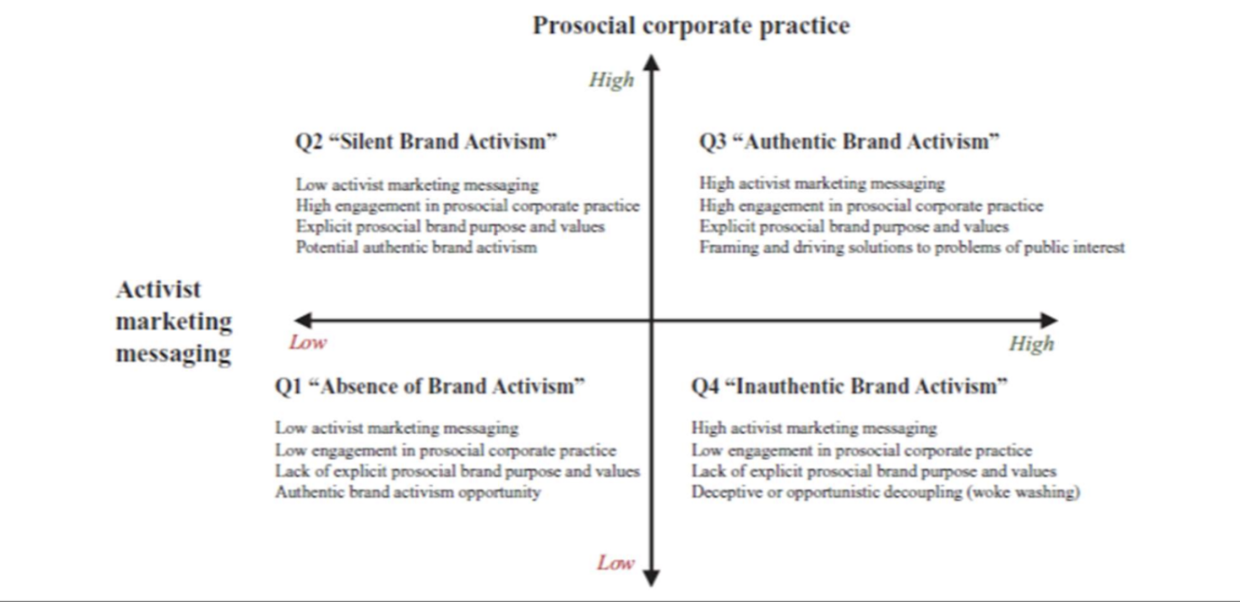
Authentic Brand Activism:
When a brand's activist messaging aligns with its core purpose, values, and prosocial corporate practices, creating both brand equity and potential for real social change.
Woke Washing
When a brand detaches its activist messaging from actual purpose, values, and corporate actions, leading to consumer mistrust and accusations of virtue signaling.
Optimal incongruence
= brands can engage in activism even if their cause does not perfectly align with their existing reputation.
This strategy can generate strong consumer engagement and brand equity, but too much incongruence risks backlash.
Example: Ben & Jerry’s expanding from environmental causes to racial justice issues.
risks & consequences of woke washing
Brands that engage in woke washing risk consumer backlash, loss of trust, and damage to brand equity.
Consumers are increasingly skeptical of brands using social causes for profit without meaningful action.
Examples include Pepsi’s Kendall Jenner ad (trivializing social activism) and Gillette’s toxic masculinity campaign, which faced criticism due to inconsistencies in pricing strategies for men vs. women (the "pink tax").
what are the 4 consumer-brand relationships?
Functionally invested = brand as colleague; satisfied w/ quality (left side)
Fully invested = brand as family; full loyalty w/ feelings & behavior (right side)
Un-invested = brand as acquaintance; low involvement/frequent switching
Emotionally invested = brand as friend; emotionally attached however functional underperformance may lead to a painful switch
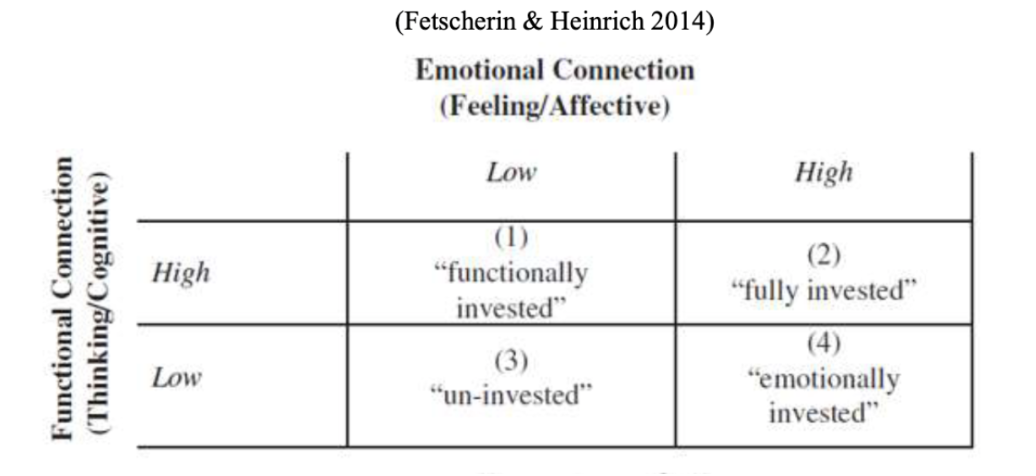
direction of affect/commitment/relationship?
brand satisfaction = + feeling, weak strength
brand love/passion = + feeling, strong strength
brand avoidance = - feeling, weak strength
brand hate/divorce = - feeling, strong strength
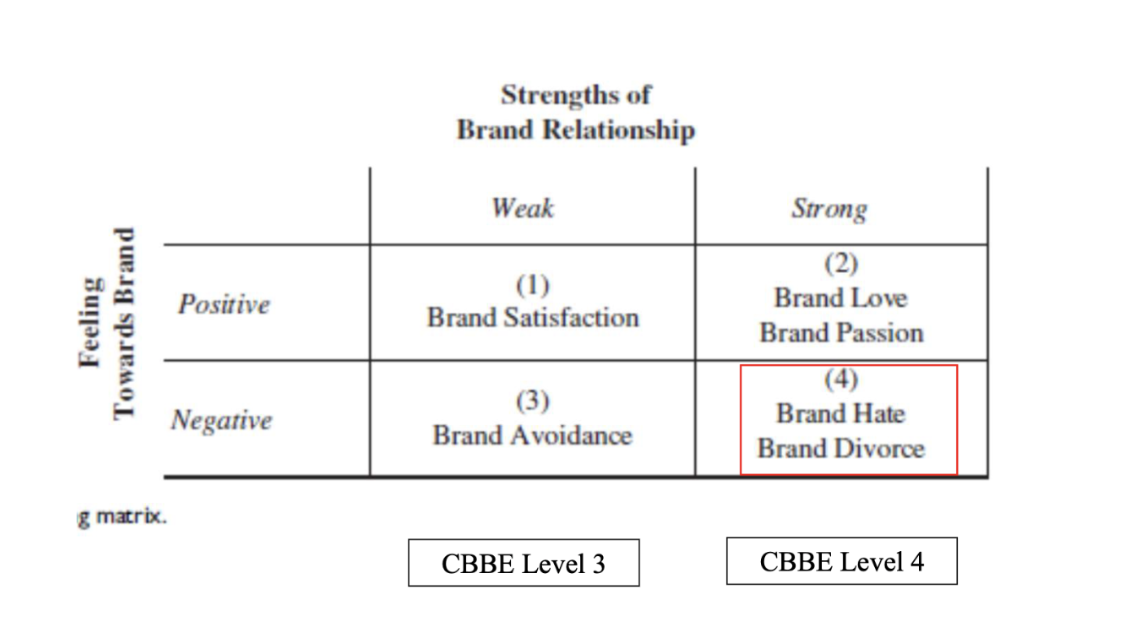
What is brand love/resonance?
“brandship”
2 components of brand resonance
brand resonance > brand loyalty because…
Attachment/intensity
Activity (consumer behavior)
resonance-related phenomena
Attending brand events
Positive WoM
Willingness to pay more
Brand community
activity x intensity plot
No loyalty = switching & low involvement
Spurious loyalty = repeat purchase & low involvement
Latent loyalty (variety seeking) = switching & high involvement
True loyalty = repeat purchase & high involvement

Seven Core Elements of Brand Love (Batra et al)
Self-Brand Integration – How deeply the brand connects with the consumer’s identity and personal values.
Passion-Driven Behaviors – Strong emotional desire and active investment in the brand (time, money, and engagement).
Positive Emotional Connection – Strong emotional attachment and affection for the brand.
Long-Term Relationship – The belief that the brand will be part of the consumer’s life in the long run.
Positive Overall Attitude Valence – A highly favorable attitude toward the brand.
Attitude Strength: Frequent Thoughts & Certainty + Confidence – Strong, unwavering beliefs about the brand.
Anticipated Separation Distress – Anxiety or distress at the thought of losing access to the brand.
what elements of brand love appear in the keller article?
Attitudinal Attachment
Active Engagement
Behavioral Loyalty
Sense of Community
how is brand love diff from human relationships?
consumer is in the driver’s seat → you are the one who determines whether or not the relationship will continue (brand has no reason to terminate the relationship bc they’re making money) → what about when a brand discontinues a product?? = gap in research
how is the brand community model diff than the traditional brand to consumer model?
the brand community model connects consumers to other consumers AND to the brand
what are the markers of community?
Consciousness of kind → legitimacy, oppositional brand equity (liking one brand = hating a diff one; e.g. if you love Apple, you hate Microsoft)
Rituals & Traditions → greeting rituals, celebrating brand history, sharing brand stories
Moral responsibility → integrating, retaining, & correcting members
what does BAV stand for?
Brand Asset Valuator
brand strength is made up of…
differentiation
relevance
brand stature is made up of…
esteem
knowledge
Brand lifecycle in BAV
New/Developing Brands | High Differentiation, low Relevance, Esteem, and Knowledge |
Leadership Brands | High in all four pillars – strong, respected, and well-known |
Eroding Brands | High Knowledge but low Differentiation and Relevance (danger of commoditization) |
Fatigued/Declining Brands | Low across all pillars – weak equity and fading market relevance |
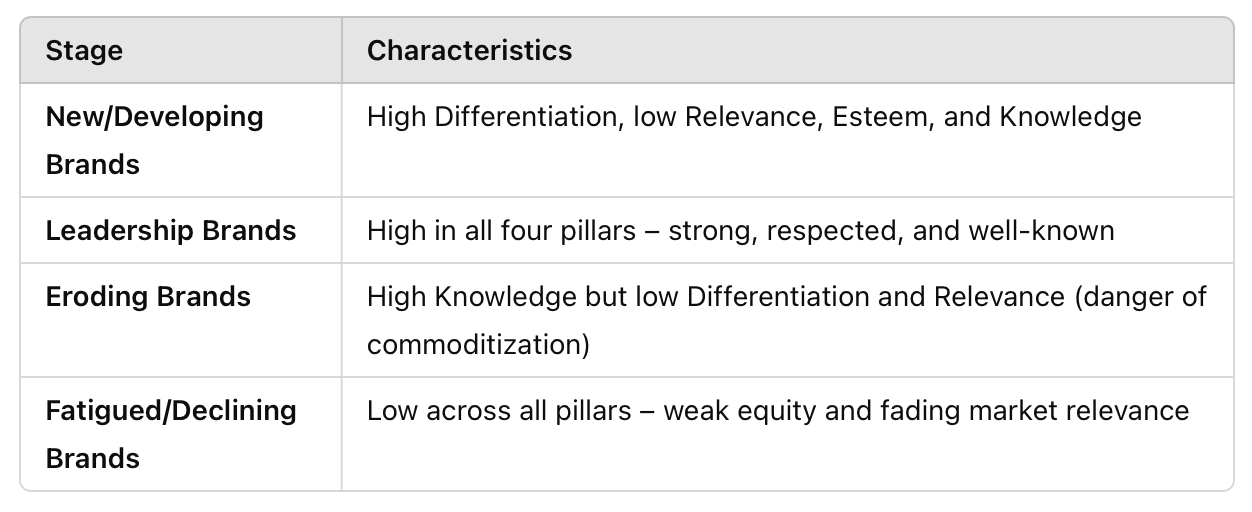
3 types of diff degrees of differentiation vs relevance
Unrealized potential: high diff; low rel —> have a reason to buy?
Commodity brand: low diff, high rel —> no PoD
Cultural icon: high diff; high rel —> strongly positioned
synopsis of byron sharp’s work
1. Brands Grow by Increasing Mental and Physical Availability
Reaching as many light and occasional buyers as possible.
Mental availability = Being easy to recall or recognize in buying situations.
Physical availability = Being widely distributed and easy to buy (channels, shelf presence, accessibility).
2. Loyalty is Overrated
Growth isn’t from making loyalists more loyal, but from gaining more buyers—even if they're not very loyal.
All brands have a similar proportion of heavy and light users — a phenomenon known as the Double Jeopardy Law.
3. Distinctiveness > Differentiation
What matters more is being distinctive and recognizable through consistent use of:
Logos
Colors
Taglines
Packaging
Brand assets (“Distinctive Brand Assets”)
4. Category Entry Points (CEPs)
Brands should build associations with multiple buying situations (e.g., “thirsty,” “party,” “health-conscious”) to increase mental availability.
This is more effective than focusing only on narrowly defined segments.
5. Advertising Reinforces Memory, Not Just Persuasion
Advertising helps brands stay salient rather than “persuade” through deep emotional storytelling.
Consistency and reach are more effective than constant reinvention.
rather than focus of differentiation. what should brands do?
focus on distinctiveness…
AVAILABILITY
Physical → distribution
Mental → salience (focus on foundation of CBBE)
Logos
Colors
Taglines
Packaging
Brand assets (“Distinctive Brand Assets”)
How are Sharp & Schultz’s ideas diff than Keller’s?
Both argue that L1 is very important BUT Sharp says L1 is the first and prob last step needed to take
Whereas Keller says L1 is important but so are rest of the levels
= they’re NOT contradictory/opposed to one another
what does WIIFM stand for?
what’s in it for me
how has social media disrupted traditional brand-building?
decentralizing control over brand narratives
brand messages are no longer dictated by companies but are co-created through user-generated content and communities
the rise of influencers and niche communities has diminished the impact of traditional celebrity endorsements
crowdcultures
online communities that rally around specific cultural interests, ideologies, and movements.
challenge mainstream corporate messaging and have the power to make or break brands.
why do most brands fail on social media?
Many brands mistakenly treat social media as just another broadcasting channel rather than a platform for engagement.
Traditional advertising strategies (like polished, brand-centric content) often fail to resonate in social media spaces.
Consumers reject corporate-sounding messages and instead gravitate toward authentic, organic content that aligns with their values.
cultural branding
brands align themselves with cultural narratives and movements that consumers care about.
Successful brands tap into crowdcultures rather than pushing traditional advertising
what’s the issue with people becoming brands?
they need brand management, just like brands do
a bad move can:
damage influencer’s personal brand directly
damage the personal AND commercial brand
even authentic posts can be seen as “inauthentic” because the authenticity aspect gets viewers to buy in and follow you = there’s still a motive
need to think of short & long term product brand associations to be authentic to audience
why does badvertising happen?
Problem w/ message/content → what? → related to brand positioning
Problem with the execution → how? → focus of Rotfield (2002) article
Entertainment focus (at the expense of effectiveness)
Need to stand out (for the wrong reasons)
what is greenwashing?
an umbrella term for a variety of misleading communications and practices that intentionally or not, induce false positive perceptions of an organizations’ environmental performance
branding related
not directly related to intentions
communication versus performance (do they align?)
can apply to other “washing”; i.e. purpose-washing, woke-washing, rainbow-washing, X-washing etc.
leads to inaccurate perceptions
when can we call it greenwashing? (Nemes)
selective disclosure
empty claims
irrelevant accomplishments
lies
just not credible
corporate responsibility in action
dubious certifications & labels
political spin
co-opted endorsement
no proof
vagueness
misleading symbols
jargon
3 master narratives of greenwashing (Supran & Hickney, 2022)
Green Innovation
mostly fossil fuel, but they all use this
Misdirection
talking about social issues unrelated to core business, like sports, fashion, diversity, social causes
accounts for 1 in 5 posts
Business-as-usual
narratives describing core business operations
used by airlines the most
which industries are worst/less bad?
Heavy Greenwashing = fossil fuel
75% posts green innovation; 3:1 green to dirty ratio
Moderate Greenwashing = car companies
60% posts green innovation; 4:1 green to dirty ratio
Subtle Greenwashing = airlines
60% posts green innovation; 1.2:1 green to dirty ratio; nature-rinsing
other greenwashing communication tactics (more subtle)
Climate silence
Misdirection - talk about social issues unrelated to core business
Rinsing
Nature-rinsing/executional greenwashing - nature pics without making a message about climate impact
“Demo-rinsing”/demographic greening and misdirection - who they post on social media is not representative of diversity present within the company
Nickerson’s 3 CSR initiatives
Corrective CSR – Directly reduces a brand’s negative externalities (e.g., sustainable packaging).
Compensating CSR – Offsets negative impact without operational changes (e.g., donations).
Cultivating Goodwill CSR – Philanthropic efforts unrelated to the brand’s business impact (e.g., scholarships).
Nickerson conceptual model
IV: CSR type
Mediator: Perceived Brand Sincerity
Moderator #1: CSR Reputation (+ or -)
Moderator #2: CSR Focus (enviro vs social)
DV: Brand Purchase
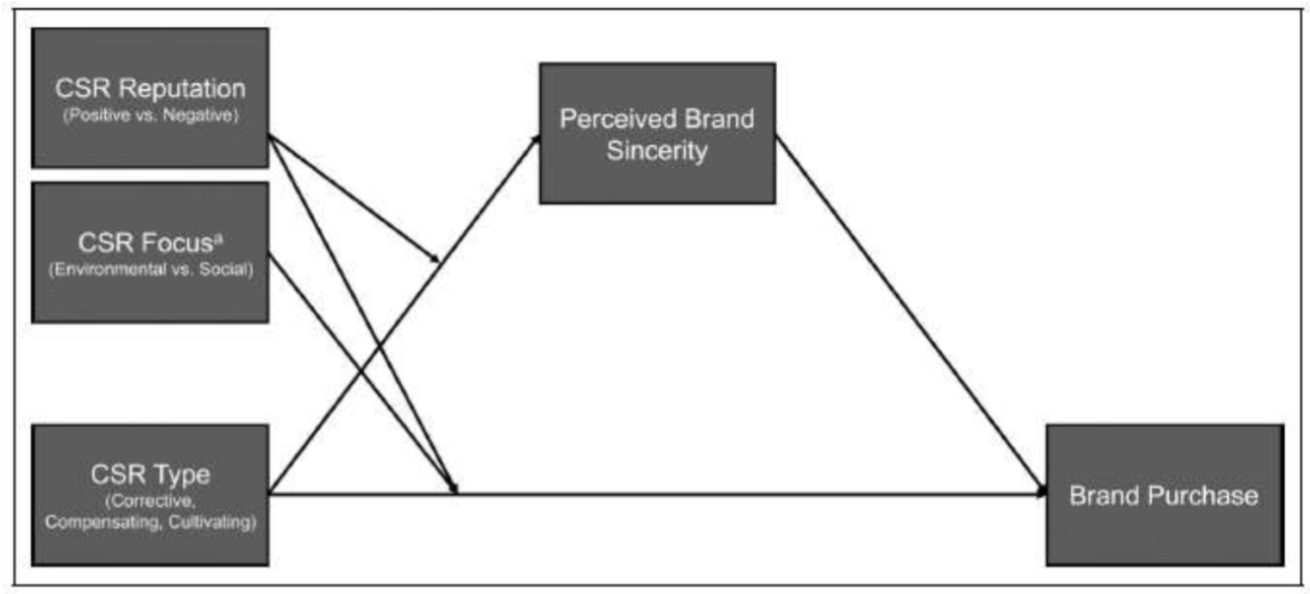
Nickerson findings
Corrective & Compensating CSR increase sales
Cultivating Goodwill CSR can reduce sales, as consumers see it as less sincere or irrelevant to brand responsibility.
CSR Reputation Moderates Impact:
Brands with high CSR reputation see smaller sales effects since consumers already expect responsible behavior.
Low CSR reputation brands benefit more from Corrective and Compensating CSR, as these efforts positively surprise consumers.
Environmental CSR (e.g., sustainability) is more effective than Social CSR (e.g., diversity programs) in driving sales, as environmental issues are widely understood and verifiable.
Sincerity mediates the effect of CSR on purchase intentions—consumers are more likely to buy from brands they perceive as authentic in their CSR efforts.
recommendations for brands based on Nickerson’s findings
Prioritize Corrective CSR: Brands should focus on reducing negative externalities rather than just promoting goodwill.
Align CSR with Brand Impact: Consumers reward brands that take accountability over those that engage in generic philanthropy.
Leverage CSR for Reputation Building: Companies with weaker CSR reputations can gain credibility and sales by focusing on corrective and compensating actions.
Emphasize Environmental Over Social CSR: Environmental CSR initiatives have a stronger positive sales impact.
where does the CSR stop? where does this lead us?
a red(der) ocean…
Differentiate further?
Palm oil, transport, employee food, etc
Different CSR focus
With new forms of criticism/washing…→ curve-washing, diversity washing, etc.
No more brand communication? (Ex: Veja)
As a “statement”
Impact on advertising on consumer well-being
Reflection of a brand value
But also with a role in positioning of sustainability
PoD: sustainable & fair
Correlational PoP: price and/or quality
RtB: saving by removing brand communication (consumers pay competitive pricing bc brand doesn’t have to pay big bucks for advertising)
Brand identity
uniquely associated with the brand in the mind of the consumer
Primary knowledge stored in brand’s associative network
Identify brand and differentiate it from competition
“Sensory Identify”: visual, verbal, auditive, tangible
= “free advertising”
Typical brand elements:
Brand names & URL’s
Logos & symnols
Characters
Slogans
Jingles
Design & packaging
criteria for choice/evaluation:
Defensive = brand building
memorability = recall, recognition
meaningfulness = product category, attributes/benefits
likability = visual/verbal imagery, aesthetics/sensory experience
Offensive = brand equity preservation
transferability = regions, product categories
adaptability = flexibility, over time
protectability = legal, competition
what does it mean for brands to leverage secondary associations?
Marketers can strengthen brand equity by associating their brand with external entities that already have established credibility and consumer trust.
what are key sources of these associations?
People (celebrity endorsements, company founders)
Places (country of origin, geographic locations)
Things (events, sponsorships, awards)
Other brands (co-branding, ingredient branding, distribution channels)
benefits/implications of leveraging secondary associations:
+: reaching a PoP or PoD through positive associations
-: lack of control over external parties that affect your brand’s image (especially with endorsers)
according to Keller, brand name fulfills which 2 criteria?
memorability
meaningfulness
according to Bossel, the brand element logo fulfills which 2 criteria?
meaningfulness
likeability
what’s the antecedent to a logo fulfilling these 2 criteria?
logo simplicity
Bossel findings about brand logo simplicity
simple logos signal health-conscious & clean ingredients
intricate logos signal luxury, craftmanship, and indulgence
Keller’s secondary sources of brand knowledge
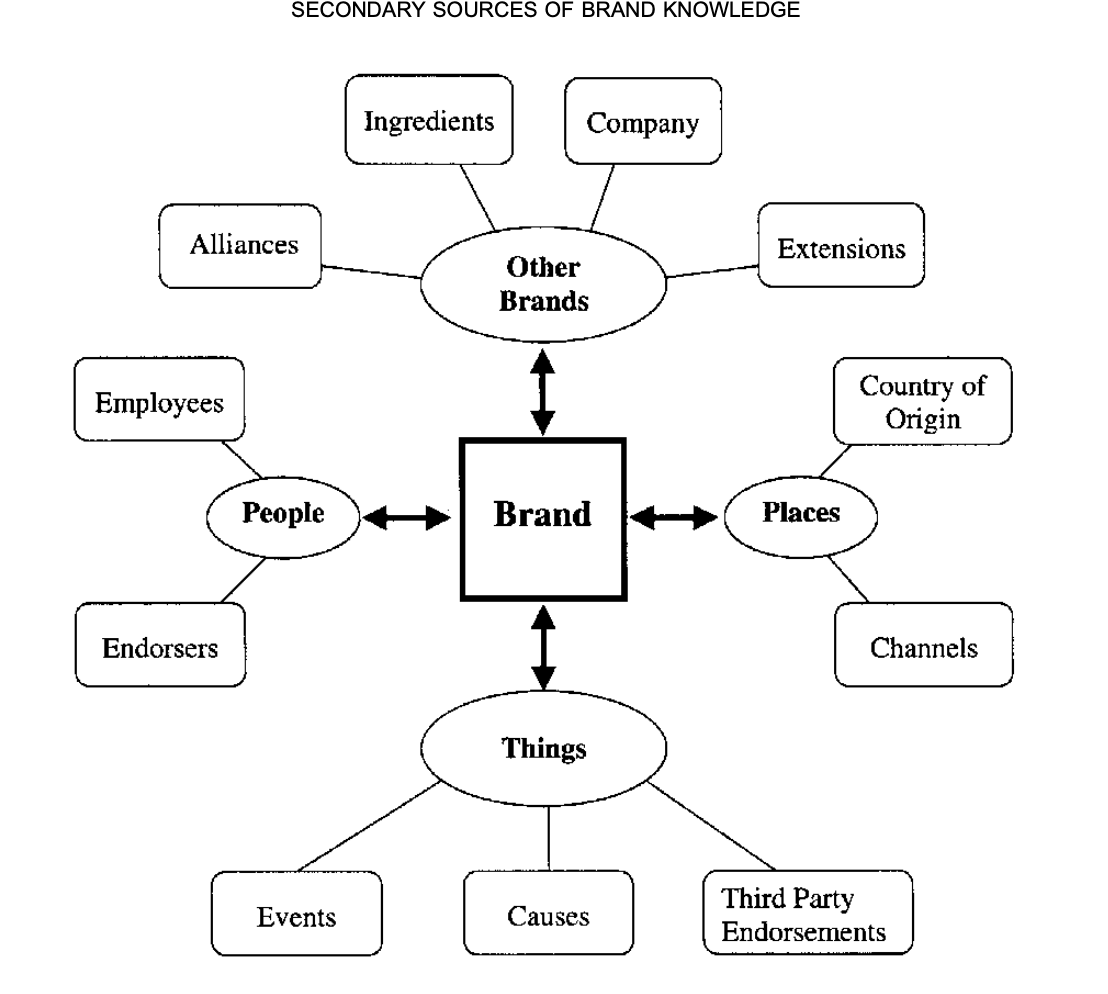
Keller’s 8 dimensions of brand knowledge in consumer’s mind:
Awareness (brand recognition and recall)
Attributes (intrinsic and extrinsic product characteristics)
Benefits (functional, symbolic, and experiential value)
Images (visual and perceptual associations)
Thoughts (cognitive responses)
Feelings (emotional responses)
Attitudes (evaluative judgments)
Experiences (actual interactions with the brand)
these dimensions collectively shape what?
brand equity!
impact of country of origin (CoO) on consumer perception
perceived COO influences brand evaluation more than actual COO
both inaccurate and accurate CoO are correct in the mind of the consumer
Implications for International Marketing Strategy bc of CoO
Secondary knowledge → loss of control over customer perceptions & subsequently brand image
Depending on reason for consumers’ misjudgement, strategically craft marketing campaigns to…
Educate: tell the real story?
Miseducate: tell inaccurate story = “foreign branding”
Smoke screen: downplay/decoy = tell different story
3 diff avenues for branding new products
new brand
existing brand = pure brand extension
new AND existing brand = brand extension w/ subbrand
3 types of brand extensions
line extensions
brand extensions
category extensions
2 processes for association leverage and extensions?
leveraging brand associations to extension product
leveraging product/category associations from extension product (to broaden brand’s associative network)
what benefits do extension products have by leveraging brand associations?
Consumer perceptions
Financial efficiency
Cover market segments
Consumer variety seeking
IF THERE’S GOOD “FIT”
what are the dimensions of “fit”? (SCT)
Substitutability
Complimentarity
Transfer
Park et al findings regarding “fit”?
two factors that affect evaluation of brand extension:
product feature similarity
brand concept consistency
findings:
= SO prestigious brands can make big jumps (& be more successful than functional brands) but only if they keep high concept consistency (= stays within core concept of luxury; and if they don’t do this, they will be hit harder than a more functional brand)
= functional brands (not luxury) vs. luxury brands
Functional brands are in the consumer’s heads for what they do, the type of product they produce
Luxury brands are categorized in consumer’s heads for being luxurious (so as long as they stay in that category then they can be successful)
= BUT both prestigious & functional brands benefit more from high similarity extensions in both low concept & high concept consistence (but still high concept consistence is preferable)
= best combination is high concept consistency AND high product feature similarity
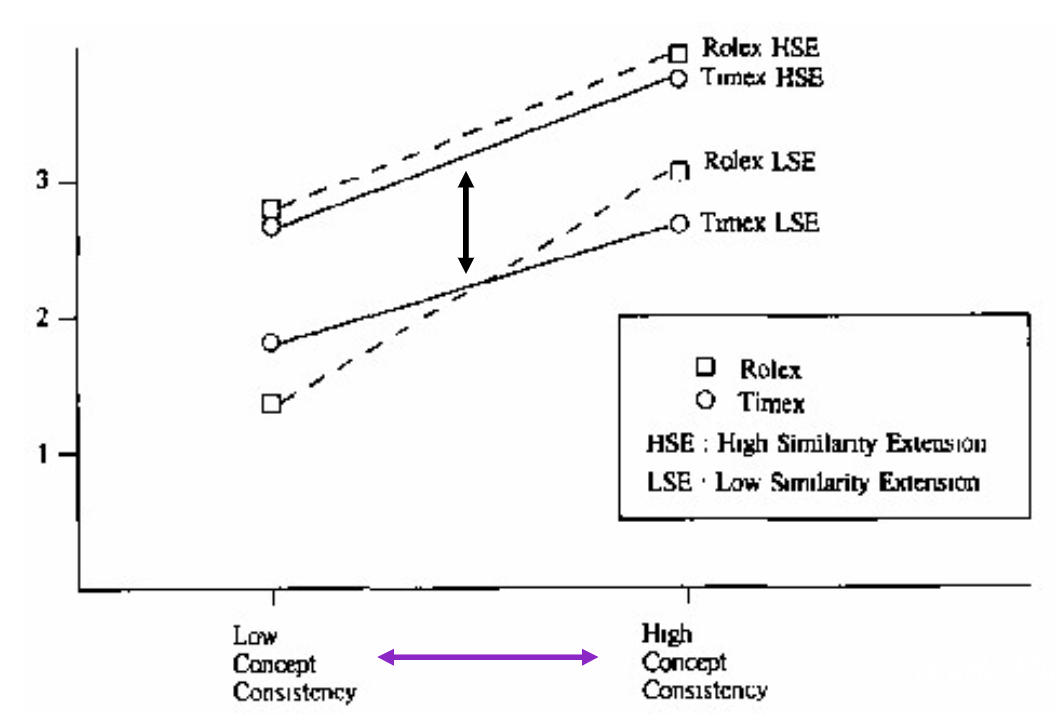
what benefits/drawbacks do parent brands experience from leveraging associations from their extensions?
Benefits = extensions can broaden market & positive feedback effects
Update consumer perceptions
Brand image, revitalization
Market coverage
Subsequent extensions
Drawbacks
Brand extension fail (Fa yogurt deodorant)
That negative association created with brand extension (from shower gel to deodorant) can now damage image of shower gel (which previously did well)
But even when they succeed?
Affects parent brand image (think lower class Mercedes car = successful with certain market, yet negatively affected parent brand)
Parent brand sales (cannibalization)
brand alliance criteria
new unique product/market entity
all involved brand names are communicated
benefits of brand alliances
Functional (product intel) vs. symbolic (reputation) benefits
Leveraging secondary associations
Extension potential into new markets
diagram for interaction in brand partner alliances
leveraging existing brand equity
updating brand’s associative network
SOOO the role of fit between brands is even more complex = have to now consider the fit between the brands themselves
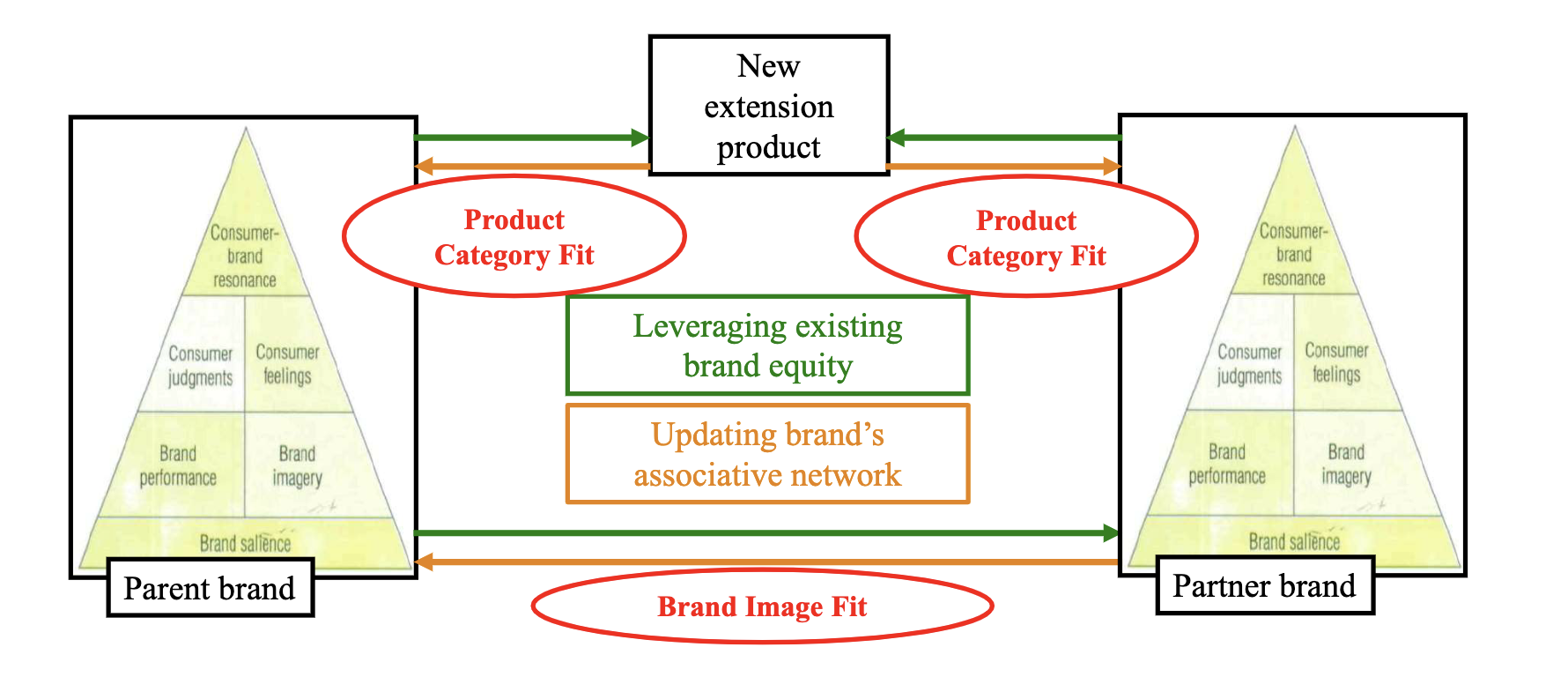
findings for partner alliances w/ luxury brands on consumer purchase intention (Moon)
brand fit is more important for luxury brands
product fit is more important for functional brands
= so it is not in TAG Heuer’s best interest to partner with a functional brand like Google or Intel